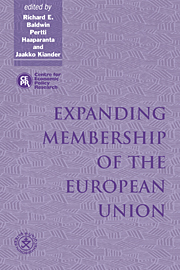Book contents
- Frontmatter
- Contents
- List of figures
- List of tables
- Preface
- Acknowledgements
- List of conference participants
- 1 Introduction
- PART ONE THEORETICAL ISSUES
- 2 A domino theory of regionalism
- 3 Customs unions, regional trading blocs and welfare
- 4 Consumer services and economic integration
- PART TWO POLICY ISSUES
- PART THREE EMPIRICAL ISSUES
- Index
2 - A domino theory of regionalism
Published online by Cambridge University Press: 05 November 2011
- Frontmatter
- Contents
- List of figures
- List of tables
- Preface
- Acknowledgements
- List of conference participants
- 1 Introduction
- PART ONE THEORETICAL ISSUES
- 2 A domino theory of regionalism
- 3 Customs unions, regional trading blocs and welfare
- 4 Consumer services and economic integration
- PART TWO POLICY ISSUES
- PART THREE EMPIRICAL ISSUES
- Index
Summary
Introduction
In the past 10 years, regional trade liberalisation has swept the world trading system like wildfire while the multilateral GATT talks proceeded at a glacial pace. This conspicuous contrast raises the question: ‘Why are countries eager to open markets regionally, but reluctant to do so multilaterally?’ Perhaps the most-widely heard answer to this question focuses on two assertions. The first is that regional integration has prospered as an alternative to multilateralism since multilateral trade negotiations have become too cumbersome to deal with today's complex trade issues. The second assertion is that the ‘conversion’ of the US from a strong backer of multilateralism to an avid participant in regional schemes has been a driving force.
This chapter discusses the shortcomings of these assertions, and proposes an alternative answer. The chapter has four sections after the Introduction. Section 2 presents a few facts about recent regionalism, criticises the standard explanation for the recent rise in regionalism and proposes an alternative answer. Section 3 presents the basic economic and political economic model. Section 4 discusses how the domino effect operates in the model, and Section 5 contains a summary and some concluding remarks.
Facts, the standard explanation and an alternative
Before discussing the shortcomings of the standard assertions and proposing an alternative answer, it is necessary to get a few facts straight. First, it is important to be more precise about the nature of the recent wave of regionalism.
- Type
- Chapter
- Information
- Expanding Membership of the European Union , pp. 25 - 53Publisher: Cambridge University PressPrint publication year: 1995
- 100
- Cited by



